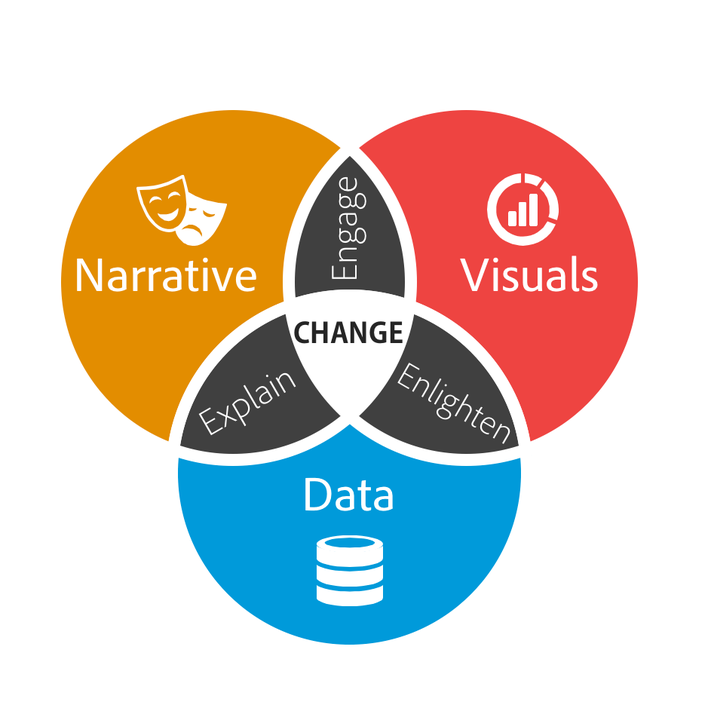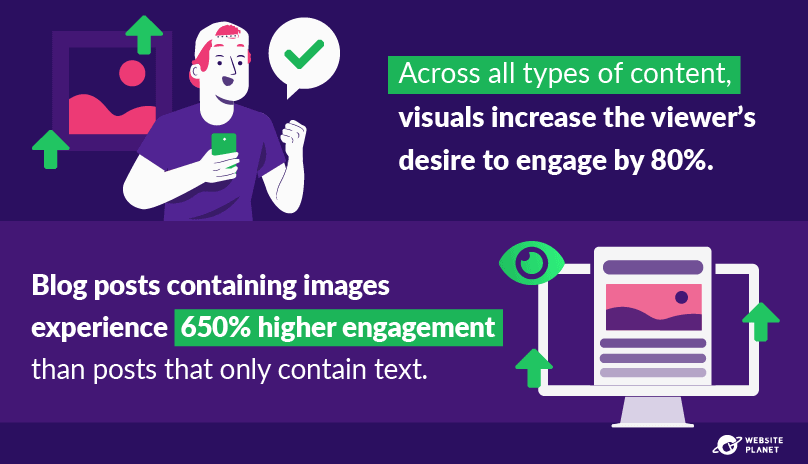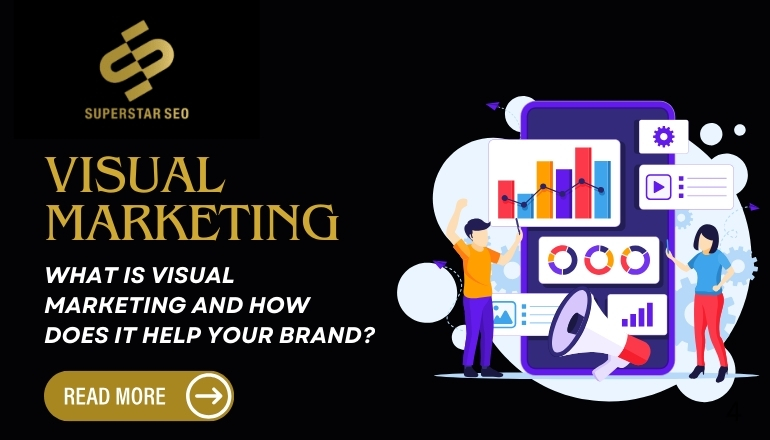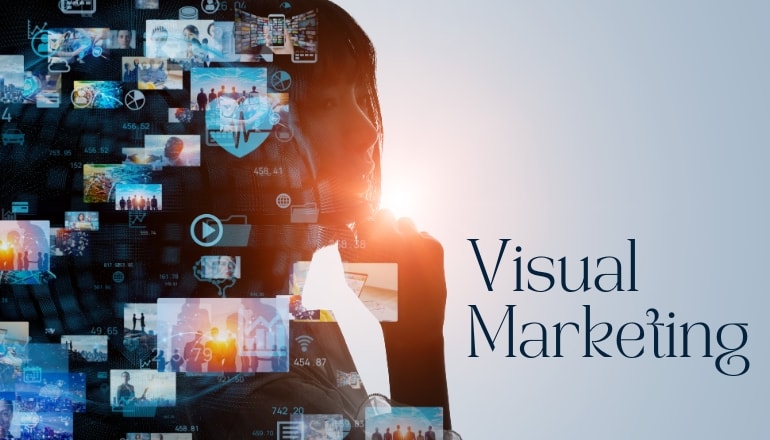The Ultimate Guide to Visual Marketing [2025]
Do you know that almost 50% of your brain processes visual information? That’s why I like to say that visual marketing is the perfect antidote to boring content that leaves your audience feeling like… yawn
In this blog, we’re talking about the main types of visual marketing, including data storytelling, interactive infographics, explainer videos, and so much more, as well as tips for each to enhance your content marketing strategy.
What Is Visual Marketing and How Does It Help Your Brand?
Visual marketing is a dynamic and exciting way to promote your brand through compelling visuals that capture your audience’s attention.
But how does it REALLY help your brand, you ask?
Visuals Grab Attention
Let’s face it; we’re all guilty of scrolling past boring text-heavy content. As visual creatures, humans are naturally drawn to images and videos, making them more effective at capturing attention. But add a stunning image or a captivating video, and suddenly, we’re hooked!
Visuals have the power to grab attention and draw your audience in, making them much more likely to engage with your brand. According to this study, visuals increase the willingness to read by 80%.
Convey Information Amazingly
Incorporating visual elements is an excellent way to communicate complex information in a way that’s easy to understand. Whether it’s through an infographic or an explainer video, visuals can break down complicated concepts into bite-sized chunks. That makes it easier for your audience to absorb and retain information.
So, a study shows how people following directions with text and illustrations do 323% better than those following text directions only.
Increase Engagement
Visual content is more likely to be shared on social media, increasing your brand’s reach and engagement. Plus, visual content is more memorable than text, meaning your brand is more likely to stick in your audience’s mind.
Actually, people recall 80% of what they SEE AND READ, vs only 20% of the information they read.
Establish Brand Identity
Visuals are an essential part of your brand’s identity, and they can help you establish a recognizable look and feel that sets you apart from your competitors.
Consistent use of visuals across all your marketing channels can help build brand recognition and loyalty.

Establish Brand Identity
Build Emotional Connections
Visuals can tap into emotions in a way that text can’t. Whether it’s through a heartwarming video or a hilarious meme, visuals have the power to make your audience laugh, cry, or feel inspired, helping you build emotional connections with your target market.
Improve Conversion Rates
Visuals can help boost your conversion rates by making your products or services more appealing to potential customers. Studies have shown that visual content can increase conversion rates by up to 80%!
Main Types Of Visual Content (+ Tips For Each One)
1. Data Storytelling
Data storytelling — the most amazing way on Earth to turn boring data into an exciting and engaging visual journey for your audience.
It’s one of the most popular types of visual content in the world of visual marketing examples, and for a good reason!
It is the art of presenting complex data in a way that’s easy to understand and engaging for your audience.
Also, it’s all about using visuals to tell a story, weaving data into a narrative that captivates and educates your audience.
That’s why effective data storytelling is a goldmine for your visual marketing efforts.
By keeping it simple, choosing the right type of visualization, and using colors very, very wisely, you can turn your data into an engaging visual journey that captivates and educates your audience.

2. Ebooks
An ebook is not only about a romance or sci-fi genre (You know that already.)
It helps brands too.
When it comes to your visual marketing strategy, they are fantastic for showcasing your brand’s expertise while also entertaining the audience.
Now, you might be thinking, “But designing an ebook sounds like a daunting task!”
However, ebook templates can really save the day. All you have to do is …a Google search.
By using a template, you can save time and make designing your ebook a breeze.
Plus, templates offer a great starting point and allow you to focus on creating content rather than stressing over design.
But what kind of content can you turn into an ebook, you ask?
Well, the short answer is…ANYTHING!!
Infographics? Articles? Blogs? Surveys? Reports? Boring research? MOTION GRAPHICS (more on that below)?
Yes, yes… and yes!
By combining different types of content, you can create an ebook that’s informative, engaging, and visually appealing.
It all depends on your final goal and your audience’s needs.

3. Infographics
We all know what infographics are, but let’s discuss how to effectively use visual elements to create impactful infographics. So let’s just skip to the part where I share some tips you have to keep in mind for your visual marketing strategy.
For example…It’s probably challenging to come up with ideas for your infographics.
So, here’s some brainstorming to get you started.
- Ride the Industry Wave – Keep an eye on the latest trends in your industry and turn them into a visual story that positions your brand as a leader.
- The Classics Never Die – Some topics are always relevant, no matter the season or industry. Take advantage of these evergreen topics and turn them into an infographic that will stand the test of time.
- Be a Trendsetter – Use popular social media trends to create infographics that capture your audience’s attention and increase your brand’s visibility.
- Newsy News – Keep up with the latest news stories and turn them into an eye-catching visual story. Who knows, it might just go viral!
- Share Your Expertise – Offer valuable tips to your audience through an infographic. Not only will you position yourself as an authority in your industry, but you’ll also provide valuable information to your audience.
Your infographic is not just a one-and-done marketing piece.
It can be utilized in multiple ways to maximize your brand’s exposure and engagement.
- Spruce up your blog posts
- Spread the word on social media:
- Power up your email marketing:
- Amp up your presentations
The beauty of infographics is that they can be used in many ways, and with the right design and strategy, they can help your brand reach new heights!
4. Interactive Infographics
Interactive infographics are one of the top visual marketing trends, offering a more engaging and gamified way to present information. This type of visual content is like “normal” infographics…but more fun and gamified, which makes them more amazing.
So…where do you start when it comes to brainstorming ideas for your interactive infographic?
What Do People Crave?
Your audience’s interests and questions should be at the forefront of your mind. Think about what topics are currently trending in your industry or what questions your audience frequently asks.
What Other Content Can You Build On?
Forget starting from scratch. You surely have some kind of reports, documents, or blogs (refer to those ideas we shared on the “normale” infographics above) you can make more fun. This will not only save you time when crafting your visual marketing strategy but also ensure that your infographic is based on reliable and valuable information.
What Data Do You Have That Is Underutilized?
Look for data that is not commonly discussed in your industry and/but that provides a unique perspective on a topic.

5. Videos
Videos can help you tell your brand story, showcase your products or services (etc., etc.,) and entertain your audience ALL AT ONCE!
Explainer Videos
Great for showcasing your product or service and explaining how it works in a simple, engaging way. Find out how to make great explainer videos.
Short Social Media Videos
With the rise…and rise…and rise of social media platforms, short-form videos have become all the rage. Create eye-catching, attention-grabbing videos that can be shared on these platforms to increase your brand’s visibility and engagement.
Youtube Videos
Don’t forget about the OG video platform, YouTube! Create longer-form videos that dive deeper into your brand story or showcase your products or services in action. Use the right keywords for YouTube and use SEO-friendly titles and descriptions to ensure that your videos are easily discoverable by your target audience.
6. Motion Graphics
Motion graphics are another element of visual marketing strategy.
In this case, it uses animation and graphic design to tell the story you want to tell.
But how is it different from other types of video?
Better Than Talking Heads
No one wants to watch a video of someone just talking to them. (It’s awkward and straight-up boring.) Motion graphics, on the other hand, use dynamic visuals and animation to keep viewers engaged and interested.
More Versatile
With live-action video, you’re limited by what you can physically capture (on camera.) Motion graphics – on the other hand – allow you to create ANYTHING you can dream up.
Easier To Update Than Traditional Animation
Traditional animation can take a long time to create and can be difficult and costly to update. Motion graphics, however, can be updated quickly and easily, making them a more flexible option.
More Memorable
While static graphics can be effective, motion graphics take things to the next level by adding movement and animation. This makes them more dynamic and memorable than static graphics alone.
Find out how to create amazing motion graphics.
Visual Marketing Strategies that Can Help You Grow
Here are some visual marketing strategies that can help you grow your business:
1. Tell a Story Visually
Visual storytelling helps your audience connect with your brand on a deeper level. Use images, videos or interactive elements to show customer journeys, highlight your unique selling proposition or explain your process. A visual of your story can make you more relatable and memorable.
Example: A series of photos or short videos of how your product solved a problem for your customers.
Tools: Canva, Adobe Premiere or other visual marketing tools.
2. Add Calls to Action (CTAs)
Visual content is more powerful with clear and compelling CTAs. A good CTA drives engagement and gets your audience to take action.
Use buttons, banners or overlay text to:
Subscribe to a newsletter
Buy a product
Download a free resource
Align CTAs with your marketing goals for better results.
3. Match Visuals to Your Brand
Your visual marketing content should match your brand identity so it’s consistent across all social media and marketing campaigns. Use your brand colors, typography and design style to build recognition and trust.
Tip: Create a style guide so all content marketers and internal comms teams know what to follow for your brand.
4. Use Interactive Visuals
Interactive content drives engagement and gives potential customers a hands on experience. Examples:
Product demos: Show users how to use your product.
Interactive infographics: Present complex data in a visual and bite sized format.
Quizzes and polls: These types of multimedia content are super shareable and can help you gather audience opinions.
5. Screenshots and Tutorials
Screenshots are great for showing features or solving problems. They’re especially useful in the content creation process when you need to present information visually.
Combine screenshots with annotations to walk users through step by step.
Good for user generated content campaigns or product guides.
6. Invest in Visual Marketing Tools
High quality visuals require the right tools. Use technology to simplify your content creation and produce professional, versatile visuals:
Canva: Design social media posts, presentations and more.
Adobe Creative Suite: For advanced image editing and graphic design.
Hootsuite: To schedule and track the performance of your visuals on social media.
7. Optimize Social Media Pages
A visual social media presence is crucial in today’s marketing landscape. Make sure your pages are:
Professional profile photos and cover images.
Content strategists creating posts that match your brand and target audience.
Consistent posting of high quality visual content that matches your marketing messaging.
FAQs
How does visual marketing work?
Visual marketing works because it grabs attention fast and retains it. People remember visuals way more than text. It increases user engagement, drives more traffic and brand recognition. By adding images, videos and infographics businesses can create a deeper emotional connection with their audience and get higher conversions.
How does visual content marketing work?
Visual content marketing works by using images, videos, infographics and other visuals to communicate messages, show products and engage audiences. It uses the brain’s natural preference for visuals to make it easier for consumers to consume information fast. When added to social media, blogs and ads it increases brand visibility and gets more interactions.
Is visual communication in demand?
Yes, visual communication is in demand especially with the rise of social media and mobile-first content consumption. Platforms like Instagram, TikTok and YouTube are built for visual content. People engage more with images, videos and infographics so businesses are adopting visual strategies to grab attention and connect with audiences in a more meaningful and memorable way.
How can visual marketing improve engagement?
Visual marketing improves engagement by making content more appealing and shareable. It grabs attention, simplifies complex messages and evokes emotions which encourages users to interact. High quality visuals get higher click through rates, more shares and increased brand recall. Videos and infographics are especially powerful to get engagement and make your content more relatable and memorable.
What are the types of visual content?
Types of visual content are images, videos, infographics, GIFs and interactive content like polls or quizzes. High quality product photos, tutorial videos and data driven infographics grab attention and convey message clearly. Visual storytelling through well designed visuals increases user engagement, conversions and strengthens your brand message across all platforms.
What are the best visual marketing tools?
Canva for design, Adobe Creative Suite for professional editing and Animoto for video creation are the best tools for visual marketing. These tools like Piktochart and Venngage are great for infographics and social media platforms like Instagram and TikTok have native features to help with visual storytelling. These tools make creating visual content easy.
How do I make them better?
Make them clear, consistent and high quality. Use bold fonts, high res images and matching color schemes. Align with your brand message and optimize for each platform. Add storytelling and make mobile friendly to make them more impactful and effective.
Final Remarks
Now that you’ve learned about the various types of visual content, it’s time to put your newfound knowledge into action!
Incorporating visual content into your marketing strategy is a great way to engage with your audience and build brand awareness.
Whether you’re creating infographics, motion graphics, or videos, there’s a visual content type that’s right for you.
Remember, the key is to know your audience and tailor your visual content to their interests and needs.
Whether you’re creating explainer videos or sharing interactive infographics, your visual content should tell your brand’s story in a fun and memorable way.






